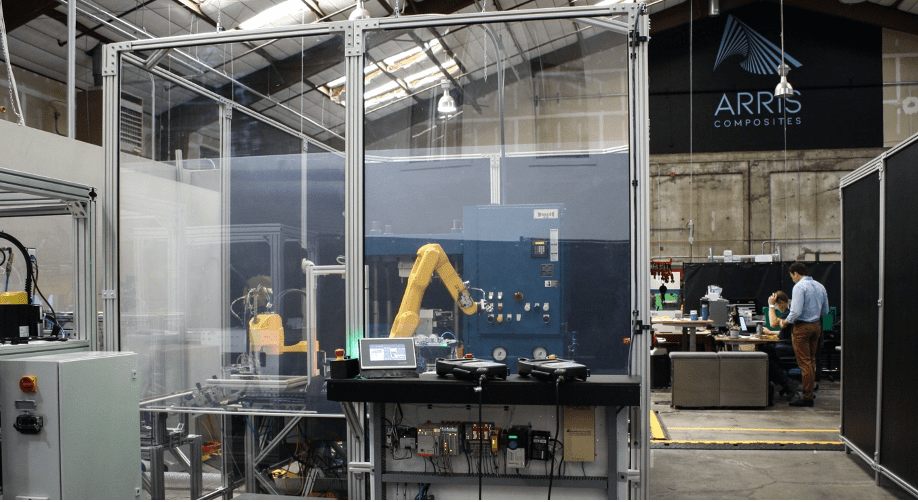Composites World Magazine Cover Article: Additive Molding Promises Mass-Produced High-Performance Composites
Additive Molding: 3D Printing Meets Compression Molding
Arris Composites introduces a patent-pending technology that manufactures high-performance thermoplastic composite components with a combination of additive manufacturing technology and high-speed compression molding.
Has mass production of advanced composite components finally arrived?
“Mass production” is a term not generally associated with complex composite components that feature continuous, aligned fiber reinforcement, yet composites technologists have long pursued this elusive combination. After all, the market potential is exceptionally large, especially in the automotive industry, for cost-efficient, high-volume, high-performance composite components.
With the exception of components pultruded into very simple profiles, this market potential has not been realized with today’s manufacturing technologies. Composites manufacturers either mass-produce complex composite components made with chopped fiber, or they use relatively low-volume fabrication technologies to make such components with continuous, oriented fiber reinforcement. Though maturing technologies like automated fiber placement (AFP) and continuous-fiber 3D printing are accelerating cycle times, they have not reached mass-production levels for complex high-performance composite components.
A recent effort to combine high performance and high volume, however, shows great promise to successfully bridge the gap. Newcomer Arris Composites (Berkeley, Calif., U.S.) caught the industrial world’s attention in May of this year when a Forbes article featured founder and CEO Ethan Escowitz. The article also covered the company’s announcement that it had closed $10 million in Series A funding — a strong endorsement of Arris’ trademarked and patent-pending Additive Molding process. Before this newsworthy event, Escowitz himself characterized the previous two years as “stealth work,” so it is only in the past few months that many composites stakeholders have started investigating and assessing the potential of Additive Molding.

High performance meets high volume
The vision for Additive Molding grew out of manufacturing innovation efforts in which two of Arris’ co-founders, Escowitz and Riley Reese, who is also chief technical officer, were involved. Escowitz and Reese worked on commercializing new 3D printing applications across multiple employers. “The impact of 3D printing on high-volume manufacturing has a history of overestimates,” Escowitz argues, “and this is due to high process and finishing costs per unit produced, plus high material costs.” (Though some 3D printers are finding ways to use commodity materials, many employ high-cost specialized materials.) The pair wanted to find a way to corral the performance benefits of 3D-printed continuous fiber-reinforced composites with the speed and cost benefits of molding technologies. Escowitz describes the idea as “aligned fiber-reinforced molding.”
Believing that a hybrid technology could be developed for high-speed molding of aligned, continuous fiber-reinforced components, Escowitz set to work. He followed the classic inventor narrative — “tinkering with new technology in his Berkeley, California, garage,” as Forbes described it. He anticipated that the technology could open the floodgates in the automotive and consumer goods markets to wide adoption of complex, high-performance composites. Sure enough, before he had even incorporated Arris Composites, Escowitz received a purchase request from an undisclosed consumer products manufacturer. His work also caught the attention of former Autodesk CEO Carl Bass, who provided seed money, consulting and space in his personal manufacturing shop in Berkeley.
Bringing on Reese as well as mechanical engineer and startup veteran Erick Davidson (now Arris chief engineer and co-founder), Escowitz continued to advance the technology and capture the attention of a growing number of composites manufacturers and customers. In the process of securing the $10 million investment, the company and its technology were vetted by former GE CEO Jeff Immelt, who was duly impressed. “What we did in automotive to replace non-structural metal with low-cost, lightweight injection molded components in the 1980s, Arris has now enabled for the rest of the vehicle,” he believes.

How it works
One key to Additive Molding is that it is vertically integrated from the point at which raw materials enter through the point at which the filled mold is ready for processing and on to demolding of the finished customer-ready parts. The process starts with dry carbon fiber tow, which is prepregged into both tape and tow form through an impregnation process. The prepreg tape may be flat, or it may be formed directly into the needed profile shape. Reese reports that Arris has in-house capability for prepreg tape production, and that a future development will make it possible to feed the tape (and tow) directly into the next manufacturing step. Currently, the company is using commercially available prepreg tape in widths of one to 24 inches, and feeding it to the next step from a spool.
Proprietary robotic equipment then shapes, cuts and places prepreg pieces into their final locations within the mold cavity. Once the prescribed prepreg is in place, the mold closes and applies heat and pressure to the composite materials for consolidation and cure. “The mechanism for placing material is different than the mechanism used in automated tape layup and 3D printing processes,” Reese notes. “We are shaping the prepregs as opposed to consolidating and bonding them in-situ. As a result, our preforming process can run at incredible speeds.”
One of the major advantages of 3D printing — the ability to place fiber at any orientation in three-dimensional space — is also true of Additive Molding. “We are bringing together the benefits of three disparate technologies for the first time,” Reese explains, “the design latitude of 3D printing, the performance of aerospace composites, and the cost and speed of molding.”
Escowitz describes the challenge that Additive Molding addresses as “scaling novel parts without the cost of traditional aligned fiber composites.” The technology, he asserts, creates structures in which “the entire volume of fiber is running along the mechanical loading pathways you desire and reinforcing where the properties are needed. We can align fibers in a way that no one else can at high production volumes.” This includes some of the rapid preforming methods recently developed, which he says require more capital equipment and cutting and consolidating time than Additive Molding does, and do not provide the level of fiber alignment that the Arris process does.
Reese continues, “By forming the shapes in our additive step, we are running the fiber paths around features, instead of cutting it out to fit around those features.” Importantly, by eliminating this cutting step, Additive Molding generates less scrap than these other processes, contributing significantly to economies of scale in high-volume production applications.
Escowitz and Reese hesitate to say just how much faster Additive Molding is compared to traditional fabrication techniques, but they expect the technology to deliver composite components at a cost that is an order of magnitude less than would be incurred with an existing manufacturing method. Reese notes that molding time is the rate-limiting step in their process — not layup. “We configure the additive portion to deliver the layup at the optimal moment for the mold cycle time,” he adds.
Escowitz points out that, with high-volume applications of aligned, high-performance composites, “It’s not the material cost; it’s the process costs” that have kept such composite materials out of consideration. Capital cost per unit is anticipated to be extremely low for aligned composite structures made with Additive Molding — low enough to make the parts cost competitive with parts they would replace, and offer much higher performance than those parts.
Full article available at www.compositesworld.com.
